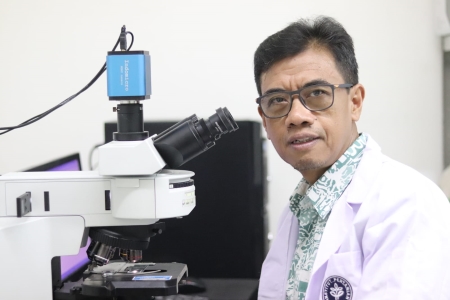Prof Abdul Munif Explains the Benefits of Endophytic Bacteria for Plant Health and Pest Disease Control

Professor of IPB University, Prof Abdul Munif, explained the role of endophytic bacteria in managing plant health and controlling pests and diseases. According to him, the use of endophytic bacteria is considered safer and more sustainable than the use of synthetic chemicals.
"The use of endophytic bacteria for controlling pests and diseases, including phytonematodes, is an alternative control that is currently growing because it is considered safer and more sustainable," he explained during the Press Conference of Pre Oration of Professor of IPB University, (26/5) online.
Prof Munif said, so far the management of plant health and control of pests and plant diseases generally rely more on synthetic chemical pesticides. The use of synthetic chemicals often causes impacts on the environment, poisoning, killing beneficial microbes and natural enemies and can lead to more resistant pests and pathogens.
He explained that endophytic bacteria are bacteria that live in plant tissue without causing symptoms of illness in the host plant. In fact, plants benefit from their existence, a symbiotic mutualism.
"Endophytic bacteria play a role in spurring growth and increasing plant yields. These bacteria can improve soil health from pollution and toxic compounds and improve plant health and protection," he explained.
Prof Munif elaborated, some of the advantages of endophytic bacteria as biocontrol agents include being safe for humans, natural enemies and the environment. Then high selectivity, so it can prevent the emergence of pest and pathogen resistance. The resulting plant products are safer from pesticide residues. And currently, endophytic bacteria are abundantly available in nature.
"Another advantage is that these bacteria can also colonize host plant tissues without causing symptoms. Its use can also save costs because it is easy to isolate and reproduce on artificial media. Its reproduction is fast, it has no potential as a pathogen and its adaptation to the environment is wide," he explained.
The results of his research show that endophytic bacteria can increase plant growth and control pathogenic fungi such as shrimp rot in rice and bulb rot in shallots by up to 50 percent.
"Another example, in tomato and rice plants, endophytic bacteria Pantoea agglomerans and Micrococcus endophyticus can reduce up to 50 percent of Meloidogyne incognita and M graminicola infections," he said.
Likewise, endophytic bacteria Ochrobactrum sp, Bacillus sp and a consortium of endophytic bacteria proved effective in suppressing the infection of Radopholus similis, Pratylenchus coffeae and Meloidogyne spp in pepper, coffee and banana plants by up to 60 percent.
"Endophytic bacteria are very potential to be developed into biological products, such as biofertilizers, biostimulants, biopriming and biocontrol agents in supporting sustainable food production and at the same time ensuring a healthy living environment for future generations," he concluded. (Rz) (IAAS/MKY)


